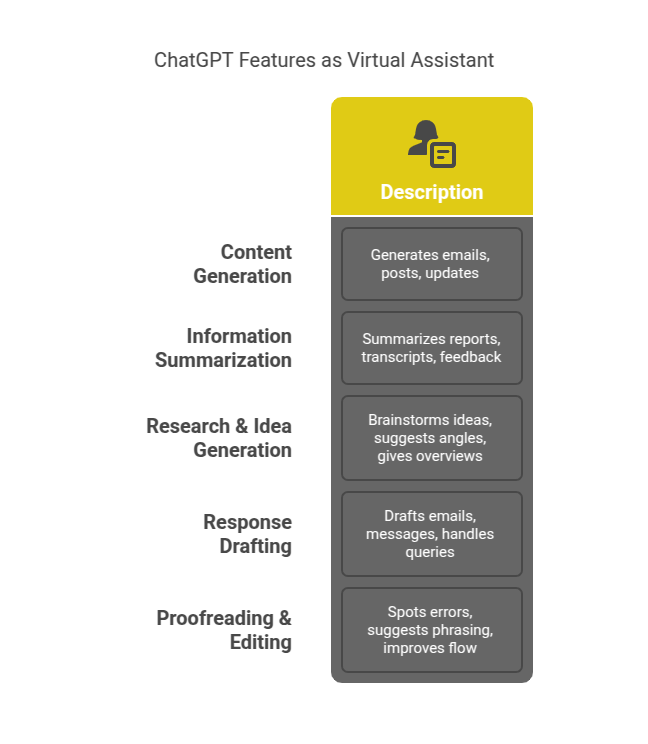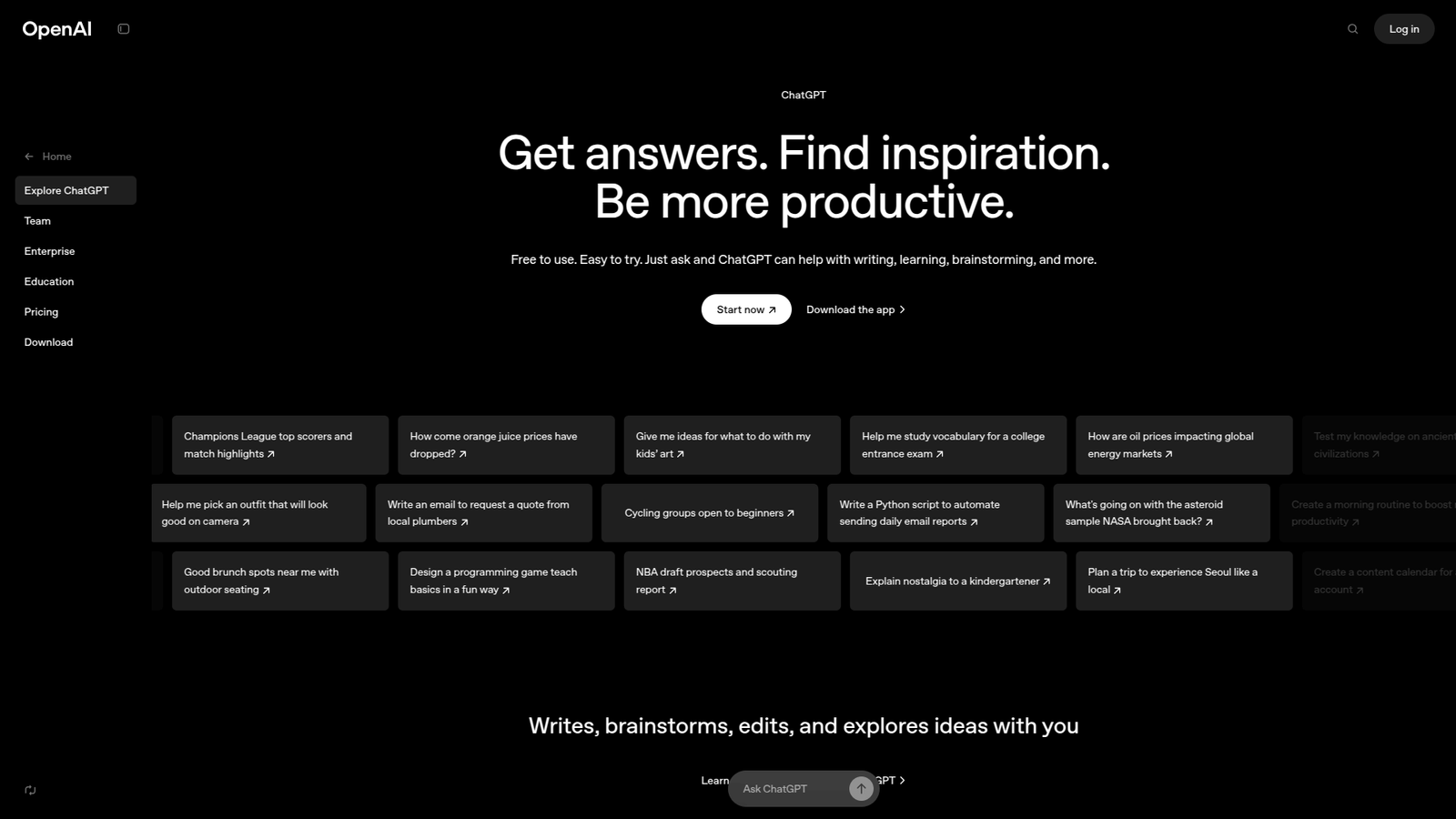ChatGPT helps you automate tasks and boost productivity in Virtual Assisting. Learn how AI transforms workflows and saves time. Discover the future of assisting now!
Why ChatGPT Is a Game-Changer in Virtual Assisting
Let’s talk about work.
Specifically, the kind of work that sucks your time and makes you want to pull your hair out.
You know, the repetitive stuff.
The emails that take forever.
The summaries no one reads.
The endless content tweaks.
If you’re in Productivity and Assisting, this is your daily grind.
Or maybe it used to be.
Because AI showed up.
And it’s changing everything.
Tools like ChatGPT are popping up everywhere.
They promise to make things easier.
Faster.
Better.
Especially if you’re knee-deep in Virtual Assisting.
This isn’t hype.
This is the new reality.
People are already using it.
Getting more done.
Making more money.
Working less.
Sound good?
Let’s get into it.
Table of Contents
- What is ChatGPT?
- Key Features of ChatGPT for Virtual Assisting
- Benefits of Using ChatGPT for Productivity and Assisting
- Pricing & Plans
- Hands-On Experience / Use Cases
- Who Should Use ChatGPT?
- How to Make Money Using ChatGPT
- Limitations and Considerations
- Final Thoughts
- Frequently Asked Questions
What is ChatGPT?
Okay, first things first.
What exactly is this thing?
ChatGPT is an AI model.
Built by a company called OpenAI.
Think of it as a super-smart text generator.
You type something in.
It types something back.
But it’s way more than just a chatbot.
It understands context.
It can write stories.
Summarise documents.
Draft emails.
Generate code.
Plan things.
The list is long.
Initially, people saw it as a writing tool.
Great for bloggers, writers, students.
But it quickly became clear it could do way more.
Especially for professionals drowning in tasks.
It’s trained on a massive amount of text data.
This means it’s seen pretty much everything on the internet.
It learns patterns.
How people talk.
How documents are structured.
How to complete instructions.
This makes it incredibly versatile.
For anyone whose job involves text and communication.
Guess what jobs involve a lot of text and communication?
Exactly.
Productivity professionals and virtual assistants.
That’s why this tool is blowing up in that space.
It’s like having a super-fast, super-informed intern who never sleeps.
Except it costs way less.
And doesn’t complain.
It just gets the job done.
Or, helps you get the job done.
We’ll talk more about that difference later.
Key Features of ChatGPT for Virtual Assisting

Alright, let’s break down what this thing actually does for someone in Virtual Assisting.
It’s got specific capabilities that make a huge difference.
- Content Generation & Drafting:
Need an email drafted?
A social media post?
A short blog update?
ChatGPT can do it.
Fast.
Just give it a prompt.
“Write an email to a client confirming tomorrow’s meeting at 2 PM GMT.”
Boom. Done.
You save minutes.
Maybe hours every week.
That time adds up.
- Information Summarisation:
Got a long report?
A lengthy meeting transcript?
A bunch of customer feedback notes?
Feed it into ChatGPT.
Ask it to summarise the key points.
It can condense hours of reading into minutes.
You get the core info without the fluff.
Crucial for staying on top of things.
Without getting buried.
- Research & Idea Generation:
Stuck on a task?
Need ideas for content?
Want background info on a topic?
Ask ChatGPT.
It can brainstorm headlines.
Suggest article angles.
Give you a quick overview of almost any subject.
It’s a creativity kickstart.
And a quick research assistant.
Saves you trawling through Google.
Or staring at a blank screen.
- Drafting Responses & Communication:
Emails?
Messages?
Handling customer queries?
ChatGPT can draft responses.
Maintain a consistent tone.
Handle repetitive questions.
This is huge for client communication.
Or internal messages.
You just review and send.
Speeds everything up.
Reduces typos.
Ensures clarity.
- Basic Proofreading & Editing:
While not perfect, ChatGPT can spot errors.
Suggest alternative phrasing.
Improve flow.
It’s a quick first pass.
Before you do a final check.
Catches things you might miss.
Especially when you’re tired.
Or rushed.
See how these fit into a VA’s day?
It hits the core tasks.
Communication.
Content.
Research.
Information handling.
These aren’t minor tweaks.
These are fundamental shifts.
Making the job smoother.
And freeing you up for higher-level stuff.
The work that actually moves the needle.
Benefits of Using ChatGPT for Productivity and Assisting
Okay, so it has features. Big deal.
What are the actual benefits?
Like, real-world impact?
For someone deep in Productivity and Assisting?
Here’s the punchline:
You get more done, faster.
Plain and simple.
Think about all the time spent on repetitive tasks.
Drafting those standard emails.
Summarising meeting notes.
Writing social media captions.
These take minutes.
Sometimes tens of minutes.
ChatGPT cuts that down to seconds.
You paste.
You prompt.
You get the draft.
Review. Tweak. Send.
That’s time back in your day.
Time you can spend on more complex tasks.
Client strategy.
Project planning.
Growing your own business.
It also helps crush creative blocks.
Staring at a blank page sucks.
Asking ChatGPT for ideas or a starting point is like flipping a switch.
Suddenly, you have something to work with.
Ideas flow.
Progress happens.
Quality improvement is another big one.
When you’re rushing, mistakes happen.
Typos. Grammatical errors. Awkward phrasing.
ChatGPT provides a solid first draft.
Often well-written.
Grammatically correct.
This means less editing for you.
And higher quality output for your clients.
It acts as a second pair of eyes.
A grammar guru.
A style checker.
Even if you’re a good writer, you miss things.
Especially when you’re tired.
Or dealing with a mountain of tasks.
Consistency is another win.
Need to maintain a specific tone for a client?
Or across different communication channels?
You can train ChatGPT on examples.
It learns the style.
And applies it.
This ensures your client’s brand voice stays consistent.
It makes you look more professional.
And makes their brand stronger.
Overall, the benefits boil down to this:
Increased efficiency.
Improved quality.
Reduced stress.
And that’s not small potatoes.
That’s the difference between being overwhelmed and being in control.
The difference between working late every night and having a life.
The difference between hitting a plateau and growing.
It’s a serious competitive advantage.
Pricing & Plans

Alright, let’s talk money.
Does this AI magic cost a fortune?
The good news?
There’s a free plan.
Yes, free.
You can sign up and start using ChatGPT right away.
No credit card needed initially.
The free version is powerful enough to do a lot of things.
Draft emails.
Summarise text.
Answer questions.
Generate ideas.
It’s a great way to test the waters.
See if it fits your workflow.
Understand its capabilities.
However, like most free tools, it has limitations.
Access can be slow during peak times.
You might not get access to the very latest models.
The premium version is called ChatGPT Plus.
This is a monthly subscription.
It gives you priority access.
Even when demand is high.
You get faster response times.
And access to newer, more powerful models.
Like GPT-4.
GPT-4 is significantly better than the models used in the free version.
It’s more creative.
Handles nuance better.
Follows instructions more accurately.
Can process longer inputs.
And it can even handle images (though that’s less relevant for pure text-based VA tasks).
For a professional relying on the tool daily, ChatGPT Plus is usually a no-brainer.
The cost is minimal compared to the time saved.
What about alternatives?
There are other AI writing tools out there.
Jasper, Copy.ai, Writesonic, and many more.
Some focus more on specific types of writing (like marketing copy).
Some have different pricing models (often based on word count).
ChatGPT, especially the Plus version with GPT-4, is generally considered one of the most versatile and powerful conversational AI tools.
Its strength lies in its ability to understand context and maintain dialogue.
Which is exactly what you need for tasks like drafting emails or summarising meetings.
For pure productivity and assisting, ChatGPT is a very strong contender.
Start with the free version.
See how you like it.
If you find yourself using it constantly, upgrade to Plus.
It’s an investment that pays for itself.
Hands-On Experience / Use Cases
Enough theory. Let’s talk real situations.
How would you actually use ChatGPT in a typical day of Virtual Assisting?
Imagine this:
It’s Monday morning.
Your inbox is full.
You have meeting notes to summarise.
Social media posts to schedule.
And a client asking for ideas for their next newsletter.
Without ChatGPT, you’re manually doing each task.
Opening documents.
Typing emails from scratch.
Staring at social media editors.
Brainstorming newsletter ideas from thin air.
With ChatGPT?
You grab the meeting notes text.
Paste it into ChatGPT.
Prompt: “Summarise these meeting notes, highlighting action items and who is responsible.”
Done in seconds.
You save that summary.
Next, you need to send a follow-up email based on those notes.
Prompt: “Draft an email to attendees summarising the key action items from the notes provided.”
It uses the summary it just created.
Writes the email.
You review. Tweak. Send.
Now, the social media posts.
Your client wants three posts promoting their latest blog article about ‘remote work tips’.
Prompt: “Write three social media posts (Twitter, LinkedIn, Instagram caption) promoting a blog post titled ’10 Remote Work Tips for Maximum Productivity’. Use emojis for Instagram.”
It generates all three.
Tailored for each platform (mostly).
You copy, paste, schedule.
Finally, the newsletter ideas.
Prompt: “Give me 10 ideas for a newsletter for a small business consultant. Focus on helping clients improve their workflow and efficiency.”
You get a list of ideas.
Maybe you ask it to expand on one.
Prompt: “Expand on idea #5: ‘Using AI tools to save time’. Give me 5 bullet points for the newsletter.”
It gives you the points.
You now have the skeleton for the newsletter section.
Think about the time saved.
On just these few tasks.
It’s significant.
It doesn’t replace you.
You’re still the brain.
You provide the context.
You give the instructions.
You review the output.
You add the human touch.
But it takes the donkey work.
The initial draft.
The summary grunt work.
The blank page terror.
This isn’t just a tool; it’s a workflow accelerator.
It lets you handle more clients.
Offer more services.
Or just work less while getting the same amount done.
The choice is yours.
Who Should Use ChatGPT?

So, who is this tool actually for?
Pretty much anyone who deals with text.
But specifically, in the context of Productivity and Assisting, the list is long.
Virtual Assistants: This is the obvious one. Email drafting, scheduling communication, content summaries, social media posts – it’s tailor-made for the VA workload.
Freelancers: Writers, marketers, social media managers, consultants. Anyone selling their services can use ChatGPT to speed up client work, create proposals, or manage their own marketing.
Small Business Owners: Don’t have a VA yet? Or need to get more out of the one you have? ChatGPT can handle some of the administrative burden directly. Drafting customer service responses, writing website copy, generating product descriptions.
Bloggers and Content Creators: Idea generation, drafting outlines, writing first drafts, summarising research. It’s a content factory helper.
Marketing Teams: Drafting ad copy, email sequences, landing page text, social media campaigns. Saves writers hours.
Anyone Drowning in Email: If your inbox is a nightmare, use ChatGPT to help draft replies faster. Filter, summarise, respond.
Researchers and Students: Summarising academic papers, brainstorming thesis ideas, drafting sections of reports.
Project Managers: Drafting meeting agendas, summarising meeting minutes, writing project updates, preparing communication plans.
See the pattern?
If your job involves:
Writing.
Reading.
Summarising.
Brainstorming.
Communicating.
Then ChatGPT can help.
It’s not going to replace the strategic thinking.
It won’t make the tough decisions for you.
It won’t build client relationships.
But it will take the busywork.
The repetitive tasks.
The blank page dread.
And handle them.
So you can focus on the stuff that actually requires a human brain.
The strategic stuff.
The creative stuff.
The relationship stuff.
If you feel like you’re constantly doing tasks that don’t use your full potential.
Or that you could handle more work but don’t have the time.
Or that you spend too much time on things a machine *could* do.
Then you should probably be using ChatGPT.
Or at least trying it.
How to Make Money Using ChatGPT
Okay, the real question.
Can you actually make money with this thing?
Short answer: Yes. Absolutely.
It’s not a magic money printer by itself.
You still need skills.
You still need clients.
But it makes you faster, better, and able to offer more.
Which translates directly into earning potential.
- Offer Enhanced Virtual Assisting Services:
This is the most direct way.
Use ChatGPT to supercharge your existing VA services.
You can take on more clients because you’re faster.
You can offer new services you couldn’t before.
Like drafting content for clients.
Summarising complex documents on demand.
Handling more detailed research requests.
Imagine telling a client you can not only manage their inbox but also draft 80% of their replies.
Or manage their social media by generating draft posts daily.
This adds value.
You can charge more.
Or keep your rates and just handle more volume.
Either way, more money per hour or more total money.
- Specialised Content Creation Services:
Become an AI-assisted content specialist.
Offer services like “AI-Powered Blog Drafting”.
Or “Rapid Social Media Content Bundles”.
You use ChatGPT to generate the first draft or ideas quickly.
Then you apply your expertise.
Edit. Refine. Add the human insights.
Optimise for SEO or engagement.
This allows you to produce content much faster than someone doing it manually.
You can offer competitive pricing or deliver more content for the same price.
Clients get value.
You make a good margin.
- Information Products & Tools:
Use ChatGPT to help create paid guides, templates, or checklists for other VAs or business owners.
“The Ultimate Email Template Pack (AI-Drafted)”.
“Social Media Content Calendar with AI Prompts”.
You can create these products much faster.
Monetise your knowledge and the AI’s speed.
You can also use it to help market these products.
Writing sales pages.
Drafting ad copy.
Let’s take an example.
Sarah is a virtual assistant.
Before ChatGPT, she could handle 3-4 clients comfortably.
Mostly admin tasks, email management, scheduling.
A lot of her time was spent writing those emails and drafting basic documents.
She started using ChatGPT Plus.
Suddenly, tasks that took 15-20 minutes took 5-10.
She automated much of her email drafting.
Got ChatGPT to summarise long client calls she missed.
Started offering content support – drafting social posts and short blog outlines.
Tasks she previously had to outsource or couldn’t offer.
Now, she manages 6 clients.
Offers a wider range of services.
Her revenue is up by 50%.
And she’s working roughly the same hours.
That’s the power.
It’s leverage.
It multiplies your output.
Allows you to scale without increasing your time linearly.
Find a bottleneck in your service offering?
See if ChatGPT can help smash it.
That’s where the money is.
Limitations and Considerations
Alright, let’s keep it real.
ChatGPT is powerful.
But it’s not perfect.
Like any tool, it has limitations.
And you need to be aware of them.
Accuracy is Not Guaranteed: This is the big one. ChatGPT makes things up. It’s confident. It sounds plausible. But it can generate factual errors. It can misinterpret data. It’s a language model, not a search engine or a fact-checker. Always, always, always verify critical information. Don’t just copy and paste something it says about dates, numbers, or specific events without checking.
Requires Editing and Refinement: The output is a draft. Often a very good draft. But it needs your touch. It can sound generic. It might miss nuance only a human understands. You need to read it. Edit it. Adjust the tone. Make sure it perfectly fits the context and your client’s voice. Think of it as a skilled junior assistant, not the CEO.
Understanding Context Can Vary: While it’s good with context, it can get confused in long conversations. Or with complex, multi-layered requests. You need to be clear in your prompts. Break down complex tasks. Provide necessary background info. Garbage in, garbage out applies here.
Handling Sensitive Information: Be cautious about putting highly sensitive or confidential client information directly into ChatGPT. OpenAI has policies, but cloud-based tools always carry some risk. For standard tasks, it’s generally okay, but use your judgment for anything highly proprietary or personal.
Learning Curve: Getting the best results requires learning how to prompt effectively. It’s not just typing a question. It’s about giving clear instructions, context, examples, and specifying the desired format and tone. This takes practice. It’s a skill.
Potential for Bias: AI models are trained on data. That data can contain biases. ChatGPT can inadvertently reflect those biases in its responses. Be mindful of this, especially when asking for information or generating content on sensitive topics.
Not a Replacement for Human Judgment: ChatGPT can draft an email. It can summarise a report. But it can’t understand the subtle politics of an office. It can’t build rapport with a difficult client. It can’t read between the lines in a conversation. Your human skills – empathy, critical thinking, relationship building, strategic decision-making – are still essential.
Think of ChatGPT as a bicycle.
It makes you faster.
Lets you travel further with less effort.
But you’re still the rider.
You steer.
You pedal.
You decide where to go.
And you have to avoid crashing.
Use ChatGPT.
But use it wisely.
Understand its strengths.
And its weaknesses.
It’s a powerful assistant.
Not a mind reader or a perfect oracle.
Always double-check.
Always refine.
Maintain quality control.
And you’ll unlock its real value.
Final Thoughts
So, where does that leave us?
ChatGPT is not just another shiny tech toy.
For anyone in Productivity and Assisting, especially Virtual Assisting, it’s a serious tool.
A workflow transformer.
It takes the repetitive, time-consuming, text-heavy tasks.
And makes them faster.
A lot faster.
It helps you generate content.
Summarise information.
Draft communications.
Break through creative blocks.
The benefits are clear: more efficiency, better output quality, less stress.
And yes, for professionals, it absolutely opens doors to earning more money.
By increasing capacity.
By offering new services.
By delivering value faster.
It’s not magic, and it’s not perfect.
You still need your brain.
Your judgment.
Your human touch.
You have to check its work.
Guide it with clear prompts.
Refine its output.
But used correctly?
It’s like adding an extra pair of hands to your workflow.
Hands that can type at impossible speeds.
And access vast amounts of information instantly.
If you’re serious about getting more done.
Serving clients better.
And freeing up your time for higher-value activities.
Then ignoring ChatGPT isn’t an option.
It’s already being used by the people getting ahead.
The ones saving time.
Making more impact.
And building their businesses.
My recommendation?
Start with the free version.
Experiment.
Find one task you do daily that involves writing or summarising.
Try doing it with ChatGPT instead.
See how much faster it is.
See the quality of the draft.
Then try another task.
And another.
Once you see the time savings stack up, the Plus version becomes a simple calculation.
It pays for itself, fast.
Don’t get left behind.
This is the future of work.
And it’s here now.
Visit the official ChatGPT website
Frequently Asked Questions
1. What is ChatGPT used for?
ChatGPT is primarily used for generating human-like text based on prompts.
In Productivity and Assisting, this means drafting emails, summarising documents, creating content, brainstorming ideas, and automating various communication tasks.
2. Is ChatGPT free?
Yes, OpenAI offers a free version of ChatGPT.
There is also a paid subscription, ChatGPT Plus, which offers priority access, faster responses, and access to more advanced AI models like GPT-4.
3. How does ChatGPT compare to other AI tools?
ChatGPT is known for its strong conversational abilities and versatility in handling various text generation and summarisation tasks.
Other AI tools might specialise in specific areas like marketing copy or image generation, but ChatGPT is a powerful all-rounder for text-based productivity tasks.
4. Can beginners use ChatGPT?
Absolutely. The basic interface is simple: you type in a prompt, and it gives you a response.
Getting the *best* results requires learning prompt engineering, but anyone can start using it effectively for simple tasks immediately.
5. Does the content created by ChatGPT meet quality and optimization standards?
ChatGPT can produce high-quality drafts that are grammatically correct and well-structured.
However, the content needs human review and editing to ensure accuracy, appropriate tone, and optimisation for specific purposes (like SEO or audience engagement).
It provides a strong starting point, not a final product.
6. Can I make money with ChatGPT?
Yes, you can make money with ChatGPT.
It helps you work faster and offer more services, increasing your capacity and value to clients.
You can use it to enhance existing services, offer new AI-assisted services, or create information products.






